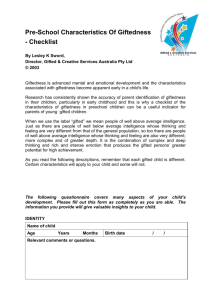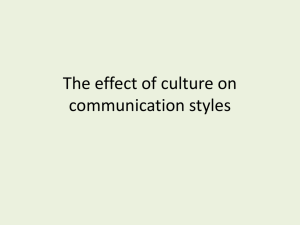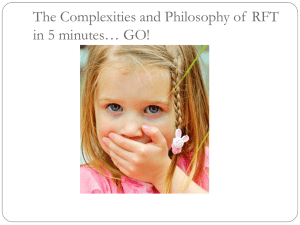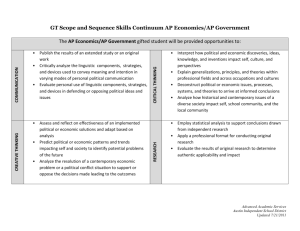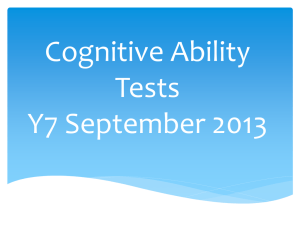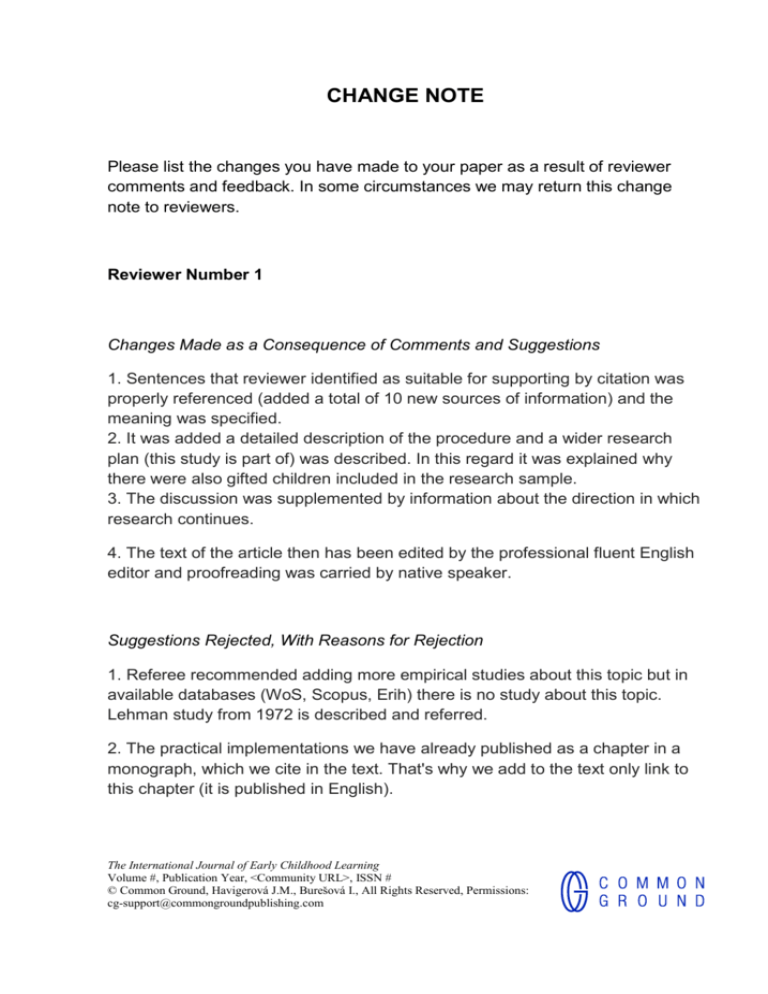
CHANGE NOTE
Please list the changes you have made to your paper as a result of reviewer
comments and feedback. In some circumstances we may return this change
note to reviewers.
Reviewer Number 1
Changes Made as a Consequence of Comments and Suggestions
1. Sentences that reviewer identified as suitable for supporting by citation was
properly referenced (added a total of 10 new sources of information) and the
meaning was specified.
2. It was added a detailed description of the procedure and a wider research
plan (this study is part of) was described. In this regard it was explained why
there were also gifted children included in the research sample.
3. The discussion was supplemented by information about the direction in which
research continues.
4. The text of the article then has been edited by the professional fluent English
editor and proofreading was carried by native speaker.
Suggestions Rejected, With Reasons for Rejection
1. Referee recommended adding more empirical studies about this topic but in
available databases (WoS, Scopus, Erih) there is no study about this topic.
Lehman study from 1972 is described and referred.
2. The practical implementations we have already published as a chapter in a
monograph, which we cite in the text. That's why we add to the text only link to
this chapter (it is published in English).
The International Journal of Early Childhood Learning
Volume #, Publication Year, <Community URL>, ISSN #
© Common Ground, Havigerová J.M., Burešová I., All Rights Reserved, Permissions:
cg-support@commongroundpublishing.com
THE INTERNATIONAL JOURNAL OF EARLY CHILDHOOD LEARNING
Reviewer Number 2
Changes Made as a Consequence of Comments and Suggestions
1. The title of the article was accompanied by subtitle. Now it contains
adjectivum intelligent and better refers to the focus of the study.
2. The key word “readiness to ask” was changed to a more concise “ability to
ask".
3. Sentences that reviewer identified as suitable for supporting by citation was
properly referenced (10 new sources of information was added to reference list)
and the meaning was specified. In one statement was removed bold.
4. It was added a detailed description of the procedure and a wider research
plan (this study is part of) was described. In this regard it was explained why
there were also gifted children included in the research sample.
5. The discussion was supplemented by information about the direction in which
research continues.
6. Description of the research participants was moved above next to the
research objectives.
7. The text of the article then has been edited by the professional fluent English
editor and proofreading was carried by native speaker.
Suggestions Rejected, With Reasons for Rejection
1. Referee recommended to add the description how the method can be used in
class to develop the questions skills. About this subject we have already
published a chapter in a monograph, which we cite in the text. That's why we
add to the text only link to this chapter (it is published in English).
HAVIGEROVÁ: The Ability of Young Children to Ask Questions: More Questions, More Intelligent Child?
The Ability of Young Children to Ask Questions:
More Questions, More Intelligent Child?
Jana Marie Havigerová, University of Hradec Králové, Czech Republic
Iva Burešová, Masaryk University, Czech Republic
Abstract: The focus of paper is the ability to ask questions - originally a natural manifestation of children's
inquisitiveness, which should be grown and developed at school. The study deals with the question skill at preschool and
early school age (children 5 to 7, N=161). Ready2ask method had been created to measure the number of question asked
via visual and linguistic stimulus. It was verified that the ability of children to ask questions varies consistently,
regardless of stimulus type. An average of 5±3 questions on visual stimulus and 2±2 questions on linguistic stimuli have
been recorded. Ability to ask questions was correlated with IQ (Pearson r= .321 to .454). Children with higher
intelligence ask usually more questions with both visual and linguistic stimulus. It was found that the number of questions
generated by the indifferent visual stimulus is a good predictor of IQ, especially its verbal component (r= .503). Short
tasks similar to our ones (Here is a footprint of unknown animal, what should we know about it? or Think of as many
questions beginning with the word ‘what’.) This might be a simple tool that can help and assistance to teachers in
kindergartens for nominating gifted children in preschool age.
Keywords: Ability to Ask Questions, Visual and Linguistic Stimuli, Preschool Children
Introduction
C
ommunication takes up the largest proportion of observable human activities. Most
people spend up to 70 % of waking hours engaged in some form of communication:
listening and responding to messages of others occupies most of this time, talking,
reading and writing the rest (Mortensen, 2008). Communication among individuals occurs in two
major forms: verbal (spoken, written, visual-motoric…) and non-verbal (Petříková, Štěpánek,
1997). Communication has changed over the past fifteen years (Rebore, & Walmsley, 2009), but
verbal based communication still have the major importance in today knowledge society
(Ferencová, 2008).
The topic of asking questions is one of the most interesting and perhaps most needed
subtopics in the area of verbal communication, we think. Why? Verbal communication is
communication of meanings by words (Ferencová, 2008). The verbal communication is
expressed through speech and language (Trzepacz, & Baker, 1993). The traditional concept (the
expression theory of meaning derived from the time of ancient Greece), says that language is an
expression of thought (Davis, 2007). The questions are as mediator for both communication and
thinking.
Verbal communication skills are important for both today and future successful life (most of
the school communication is held on spoken or written language, Rebore, & Walmsley, 2009,
most commonly used types of the corporate communication are verbal based, Ferencová, 2008).
School is an environment where the skills needed for a successful life should be identified and
developed. From the above mentioned information it implies that schools should encourage and
develop children's ability to ask questions.
This article is about the relationship between the questions and the ability to think (extended
to general intellectual ability, operationalized as IQ).
Communication
The topic of asking questions belongs to the communication topic. Although it is not easy to
define communication, modern dictionaries and handbooks mostly define communication as the
imparting or exchanging of information by speaking, writing, or using some other medium;
THE INTERNATIONAL JOURNAL OF EARLY CHILDHOOD LEARNING
sending or receiving information; connection between people or places, and to communicate
means to share or exchange information, news, or ideas; impart or pass on (information, news, or
ideas); convey or transmit (an emotion or feeling) in a non-verbal way; succeed in conveying
one’s ideas or in evoking understanding in others; be able to share and understand each other’s
thoughts and feelings (Oxford dictionary, 2013). The original meaning of the word is derived
from late Middle English and then from Latin verb communicare, which originally meant
“participation in something common” and “making something common, sharing something”
(Vybíral, 2009).
Language and speech
The language is the main although not the only tool of communication. The skill of
mastering a language is learned gradually (for example syntax developed from holophrastic
speech to a strictly structured two-term system using open and pivot words, Hart et al., 1999),
and it develops and changes throughout life of both an individual and society (for example
changing the active dictionary, Bussmann et al., 2013, language adaptation, Coulmas, 1989).
The latest research proves that a child is not just a passive learner who learns only by hearing
and absorbing the language patterns of older speech emitters (Craighead, & Nemeroff 2002 state
it was a frequent attitude in early 1960´s), and that children´s speech starts to develop in the
period long before the very first verbal utterances. The roots of language acquisition can be
traced as early as to prenatal stage when specific communication occurs mainly between the
mother and the fetus (see for example Janik 2004). Even before a child starts using meaningful
words, he or she produces a range of pre-speech and non-verbal products in the course of the first
year of life. The child may cry, produce baby talk, laughs or shouts, repeats various speeches
sounds, imitates lip movement, and uses gestures. Before the child himself or herself starts
speaking, he or she demonstrates comprehension of verbal stimuli from adults (already between
9-10 month children show comprehension of at least a few words and phrases, Schlinger, 1995).
As for William Stem (1924, as cited in Gagarina, & Gülzow, 2006) described it, children
understand the meaning of words and simple sentences usually a few months earlier before they
utter their first words and two-word sentences (f.e. Friedenberg, & Silverman, 2012).
Before mastering speech itself, children between 9 and 18 months of age learn basic
communication rules. Their non-verbal messages are adapted to the recipient, and during their
communication they follow rules which are analogous to verbal communication. Children are
motivated to communicate by their need to express wishes and to maintain contact. These needs
stimulate the development of language competences (Spodek, & Saracho 2005).
After the above-mentioned development of language skills at the toddler stage verbal
competences improve at pre-school age as far as both the form and the content are concerned.
Such development is mainly realised through the communication with adults, peers, and also
through the influence of media. In this period children are already able to express their attitudes,
requirements and feelings (Vágnerová, 2005).
Question as a concept
A question is any sentence which has an interrogative form or function (Weber 1993).
According to Chomsky we can say that the ability to question is innate to human, because
questions are a natural part of language and the language is innate to human, our mind is
constructed for (Gross, 2012). The first signs of questioning occur very soon. Children are able to
express non-verbally (wordless questions) or with a question intonation of one or more words,
without using grammatical form of interrogative sentences (Crystal, 2010). The first observable
manifestations of this ability are already apparent at the age of eighteen months (a period referred
to by linguists as the first age of questions) when the questions “who” and “what” appear. After
the second year, children begin to use more first interrogative pronouns and interrogative adverbs
HAVIGEROVÁ: The Ability of Young Children to Ask Questions: More Questions, More Intelligent Child?
(where, when, how). Children first learn the structure of closed questions, which usually does not
cause any problems for them. Later, questions are starting to be open ones, initially with
inadequate word order, which is then adapted (Pinker 1996).
The division between the toddler and preschool developmental periods (around the 3rd year)
is a period that includes a rapid development of the skill of asking questions; all other types of
questions appear, including the most significant questions for this age – those starting with "why"
(Lechta, 1990). From that moment a person anchors his or her experience with asking questions.
With age, children develop the physical and cognitive skills that allow them to interact with
others and they also develop the linguistic skills necessary to express their ideas and address the
substance of questions asked of them (DeRuiter, 2012). From the age of around three years
questions become a permanent part of the cognitive structures and communication skill (or
should become, if their production is supported, because the question skill, just like any other
skill, if not strengthened, it may disappear, Paas, Renkl, & Sweller 2003).
As the child develops, asking questions is becoming more sophisticated. Firstly, it extends
the range of questions (how many ways he asks), secondly, the child expands the sources of
information (whom's asking) (De Ruiter, 2012). Fitneva and Dunfield (2010, as cited in
DeRuiter, 2012) found that even three-years-olds prefer the reliable informant and by age six,
children clearly prefer to direct questions about games to children and question about cooking
and driving to adults.
The ability to ask questions is not an isolated phenomenon; it is associated with a variety of
mental functions. First, a question is a product of thinking and experiencing processes. A
question naturally arises in the human mind in a situation where the individual lacks some
information – he or she is thinking about something and the stream of thought stops because
he/she a) does not know something, or b) is not sure of something. At this moment, experience of
a feeling comes into a play (a feeling of insecurity, curiosity, etc.) and the need for information
arises (I want to know, I would like to know, I need to know, I should know, etc.). (Wilson
1981). On the other hand, a question acts as a trigger to the cognitive processes. Ramey and
Meegan (2011) literally say that “questions generate thinking.” The two basic types of questions
evoke two different types of thinking: closed questions trigger convergent thinking, while open
questions trigger divergent thinking. Ramey and Megan, in the same breath, add: “The problem
is that questions generate thinking, while answers stop thinking in its tracks. Only through
questions do our minds truly think.” (Ramey & Meegan 2011) Questioning promotes memory,
inquiry and acts as a stimulus for student talk, engagement and in-depth processing of complex
concepts (Feldman, 2003; Noor et al, 2012; Richards & Lockhart, 1996). Ability to ask questions
is related to problem solving. Blank & Covington (1965, as cited in Dillon, 1998) were trained
certain group of student to ask questions, in a post-test questioners were able to solve 16 % more
problems (Science Achievement Test) than non-questioners.
It is therefore very important that the educational process activates thinking and supports the
ability to ask questions, instead of the traditional transfer of complete knowledge, or passive
responses in terms of the pupil.
The ability to ask questions not only develops and activates thinking and cognitive abilities,
but also strengthens the experiencing and sociability and Truhlářová (2003) presumes it can also
take off the prevention of social exclusion and deprivation of the child (the child who is
questioned feels to be part of society and is experiencing more positive feelings). The ability to
ask questions is also closely related to the level of curiosity in someone´s character (Havigerová,
& Haviger 2012), the support of which plays an important role in positive education (the aim of
positive education is to foster the positive strengths of personality and uniqueness is one of them,
Slezáčková 2012). All these are the reasons why we are dealing with the ability of ask questions.
The relationship between intelligence and the ability to ask questions
Robert Sternberg once stated that the ability to ask questions is “a vital half of intelligence”
THE INTERNATIONAL JOURNAL OF EARLY CHILDHOOD LEARNING
(Sternerg 1987, 11). Dillon (1998) aptly stated that we cannot measure intelligence without
requiring examinees to ask questions as well as to answer them. Tizard and Hughes (1984, as
cited in DeRuiter, 2012) provided numerous examples what they called “passages of intellectual
search”. These passages reveal the persistence of children looking information and their active
attempts to reconcile the new information with pre-existing concepts.
The relationship between intelligence and the ability to ask questions was measured by
Lehman (1972). He found significant correlation (r=.31) with ninth-grade students. The
relationship between intelligence and the ability to ask questions can be derived from the
relationship between intelligence and creativity. The same study of Lehman shows the higher
correlation between ability to ask questions and creativity. The studies of similar nature in
younger children are not available.
Method
Objectives
This study presents partial results of a larger research project called “Ready to ask?”
(Information behaviour of children in pre-literate period, giftedness based study), which was in
the years 2011-2013 supported by the Czech Science Foundation. The aim of the project was to
describe the information behaviour of children in the preschool age (at the time when the child
has not fully developed reading literacy). Within this project it was translated and validated on a
population of Czech preschool children method for giftedness screening Characteristics of
Giftedness Scale (CGS), manipulative questionnaire was created to measure information
resources used by preschool children to acquire information about topic they enjoy (IB -A) and
its paper-pen version for their parents (IB- R). The basis of information behaviour is the ability to
ask (the ability to formulate, what exactly I want to find out?), therefore our essential attention
was focused on the ability of children to ask questions. A method for measuring ability to ask
questions Ready2ask (R2A) was developed, that is described in this.
The aim of this study is to determine whether there is a relation between the level of
intellectual ability and the ability to ask questions, depending on the type of stimulus that
encourages the questioning in the preschool age. We have formulated the following research
questions:
1. Is there a relation between the level of intellectual ability and the number of questions which
are generated by children in reaction to an indifferent visual stimulus?
2. Is there a relation between the level of intellectual ability and the number of questions which
children ask when provided with linguistic hints?
Type of study
The research derives from postpositive knowledge claim (Creswell, 2003) and has
quantitative design. Quantitative design for this study was chosen because 1, the study aims to
generalization (can it be generalized that ability to ask question is a manifestation of intellectual
abilities?), 2, this correlational research attempts to determine the extent of a relationship
between two or more variables using statistical data (the more intelligent child, the more question
she or he is able to ask?), 3, the variables are not manipulated (they are only identified).
Participants
Within the framework of the whole research data were obtained and proceeded from about
1,106 children who came from 18 kindergartens and 2 primary schools (with first class for gifted
children), 606 parents, 26 kindergarten teachers and 4 primary school teachers participated as
informants. The research data for this study were obtained in the course of two years from the
HAVIGEROVÁ: The Ability of Young Children to Ask Questions: More Questions, More Intelligent Child?
total of 161 children aged 5 years 5 months to 7 years and 1 month. Conditions to be included in
research were as follows: he or she is in the preschool age (in our country's compulsory
education started in 6 years), his/her parents agreed on the participation in research and he or she
was present in a kindergarten during testing (mostly during May and June to have perhaps the
oldest children). In the first year there were 61 children tested from three cooperating nursery
schools (one town nursery school, one housing estate school and one village nursery school, one
rural), always the whole preschool class. Of these children, only 1 appeared to be gifted
(according to the rules used in our country is the main criterion of giftedness IQ > 130). At the
turn of December and January we conducted all-over screening of children in the preschool age
in all 18 kindergartens under our municipality (there were registered 935 pre-schoolers, we
received CGS scores about 885 of them). From these 93 children showed above-average scores
on CGS (according to parents and / or teachers filling-out) during the second year we went to test
these children into their nurseries. During May and June were tested 65 children, 7 of them gain
in the method WISC total score > 130. Because our study focuses attention on gifted children, we
have decided to expand the research group and in September (immediately after the onset of the
first class) we attended primary school for gifted children, where we tested 44 children ( 22
children in a class for gifted children and 22 in parallel first class). The final research sample
consist of 161 children, 19 of them have been measured IQ > 130.
Procedure
At the beginning we should point out that we are in a long term cooperation with the
participating kindergartens, most of their teachers have passed through our 80-hour training on
gifted child topic during 2007-2009 period (project Nadané dítě.eu – Gifted child.eu), they are
used to informing us if they have potentially gifted children in their class (younger children who
we tested are not included in this research sample) and in those nurseries commonly
implemented training of our students. With several students we rehearsed program for the whole
class. Firstly we went to the nursery and introduced ourselves as researchers. To underline the
impression we had white coats. We were talking to the children about the work of researchers (it
was checked, however, the question that would be heard in the context of individual interviews
was not asked). Followed by controlled activities that are somehow related to the work of
researchers (activities were rotated according to the material that was available and in relation to
both children and students, to keep them enjoyed) - the most popular was drawing a UFO.
During the joint activities that led students, the two of us (psychologists) we called individual
children (in the first wave and in the primary school of all children in the class, in the second
wave of nominees) to participate in some kinds of “a job interview” to be a new member of our
research team (see below). All of the children were given a sticker like a badge of our research
team at the end of the interview and a small reward (pencils, erasers, sharpeners and sometimes
candy). The students were instructed to avoid as far as children talk about what we were asking
during the individual interviews.
We had also asked the children to try to keep our research as a secret, but of course cannot
exclude that answers of some children were partly contaminated by information from other
children. The vast majority of children enjoyed the testing, often arguing over who goes first (for
the sake of completeness, I remember one child who did not want to come to us, it turned out that
the reason was the activity he did not want to lose – outside it was warm and the other children
went to the garden with a pool – and one child refused to generate questions on indifferent
stimulus as considered the task to be primitive, however the same boy at the same meeting
generated many questions with a linguistic hint – his IQ was 131). With each child we met twice,
sometimes three times.
Data acquisition methods
THE INTERNATIONAL JOURNAL OF EARLY CHILDHOOD LEARNING
Two methods have been used to achieve the research goal. To verify the level of intellectual
ability a standardized intelligence test Wechsler Intelligence Scale for Children III (WISC III)
was used. It is a generally known method; therefore we do not provide its closer description in
this paper.
To verify the ability of children to ask questions we used the Ready to Ask method, which
was specifically created for the purposes of our research. The method consists of four
continuously connected parts that appear as a compact unit.
1. Contact – the first part of the administration is the initial contact with the child in the
nursery school. It was established through a neutral interview with questions such as “What´s
your name?”, “How old are you?”, etc.
2. Initial motivation – we motivated children by telling them about a research team which
was looking for a new researcher. From the child´s point of view, the whole questionnaire was
thus a sort of “a job interview” for a vacancy of a researcher in our research team. We motivated
the children with questions such as: Do you have an idea how to recognize a good researcher?
Would you like to be a part of our team? Do you know what a researcher does?
3. Spontaneous generating of questions with the visual stimulus – here we moved to the part
where a child is exposed to indifferent visual stimuli (a shadow and a footprint of an unknown
animal). Administrator says to child: “Look here. Here is the picture of animal footprint. No one
has seen before such a track. Nobody has seen the animal the track belongs to.”
After taking a look at the picture, the children were encouraged to ask spontaneous
questions about the picture. In this part we tried to motivate the child through thought
encouraging questions:
What could we find out about the animal?
What would you like to find out about it?
What could your mum/dad/teacher be interested in?
What else would you have to find out if you wanted to tell other children about it?
What else would you like to know?
What would the most interesting question be?
What could its name be?
4. Directed generating of questions upon linguistic hints followed. Administrator says:
“Have you noticed that some of the questions are similar, it should start at the same word? Try to
think of questions that begin with what.” The child is provided with the open question word, and
asked to come up with as many questions starting with this word as possible. The question words
were chosen and ordered in the sequence as they appear in child´s development. The words
included to this research:
Who?
What?
When?
Where?
How?
Why?
At this stage the child is only encouraged with recommendations, such as: Try to say the
word aloud.
Each interview is recorded on the voice recorder and questions generated by children are
also written to the answer sheet.
Results
Description of the research sample with regard to the measured IQ
HAVIGEROVÁ: The Ability of Young Children to Ask Questions: More Questions, More Intelligent Child?
Table 1: Research sample with regard to IQ distribution: descriptive statistics (N=161)
Min Max Mean
SD
WISC total IQ
67
152
109,97
17,817
WISC verbal IQ
69
148
108,88
17,836
WISC performance IQ
68
143
108,75
15,712
With regard to the presence of extraordinarily gifted children, the average of the research
sample is obviously higher than a statistical average of a random representative sample. The
minimum, maximum and standard deviation figures confirm that otherwise, with regard to IQ it
is a “normal” research sample.
Number of generated questions
Table 2 shows the number of questions generated by the children in reaction to an indifferent
visual stimulus (the first line), and the number of questions generated upon linguistic hints.
Table 2: Numbers of generated questions according to different types of stimuli: Descriptive
statistics (N=161)
Number of questions
Mean
SD
Min
Max
Median
generated upon visual stimuli
5,14
3,355
0
10
5
generated
upon
linguistic stimuli
WHO? Questions
2,02
1,785
0
5
2
WHAT? Questions
1,95
1,639
0
5
2
WHEN? Questions
2,04
1,742
0
5
2
WHERE?
Questions
HOW? Questions
2,19
1,634
0
5
2
2,32
1,801
0
5
2
WHY? Questions
2,34
1,854
0
5
2
There were 10 spontaneously generated questions recorded, and the most first 5 questions
with linguistic hints, the measured maxima correspond with these figures. On average the
children generated 5 questions spontaneously and 2 questions when given linguistic hints.
Relation between the number of questions and the level of intellectual abilities
The relation between ability to ask questions (operationalized as a number of generated
questions) and the level of intellectual abilities (operationalized as an IQ score) was verified
through the calculation of the correlation coefficient.
Table 3: Relation between the number of generated questions and IQ: Pearson correlation
(N=161)
Questions
upon Who?
What?
When?
Where?
the visual stimulus questions
questions
questions
questions
WISC total IQ
,454
,406
,398
,321
,345
WISC verbal IQ
,503
,432
,421
,341
,356
WISC performance
,328
IQ
Significance of all correlations is p<0.01.
,293
,280
,229
,248
THE INTERNATIONAL JOURNAL OF EARLY CHILDHOOD LEARNING
The value of the correlation coefficient ranges from 0.229 to 0.503. All correlations are
statistically significant at 1% level of significance. Higher correlations occur between the number
of questions and verbal IQ. This result can be freely interpreted in the way that the higher the
verbal IQ of a respondent is, the more questions concerning an indifferent stimulus he or she is
able to generate. The highest correlation value was observed between verbal IQ and the number
of questions generated upon the visual stimulus, the number of these types of questions thus
appears to be the most reliable indicator of verbal IQ in this context.
Discussion
The paper deals with the main research question whether there is a relation between the level
of intellectual ability, expressed through an IQ score, and ability to ask questions of preliterate
children (within the meaning of both children in the preschool age, i.e. around 6 years old, who
are not fully literate, i.e. have not fully developed reading skills). We expected that, in
accordance with the results of Lehman in older children (sixth and ninth grades), will also be in
the group of younger children (pre-schoolers and first grade pupils) confirmed the relationship
between the ability to ask questions and level of cognitive ability. We found out that the value of
IQ positively correlates with both the number of questions generated upon indifferent visual
stimuli, and the number of questions generated upon linguistic hints.
These findings are consistent with the existing knowledge of intellectually gifted
children: “Gifted children making more demands of their parents — asking more questions and
asking for more challenges, and getting more answers and opportunities — than did non-gifted
children” (Lewis, & Feiring, 1998, 14). “Young gifted children may also be exceptionally
curious, ask more questions than other children, be excellent problem solvers, and exhibit more
resourcefulness” (Charlesworth 2011, 467). It seems that gifted children have higher intrinsic
need to ask. The results of our study suggest that the higher the IQ, the more questions
children ask, even if they are provided with the external stimulus (and external stimulus may
be replaced with extrinsic motivation) and regardless of whether it is a visual or linguistic one.
The relationship between the number of questions and intelligence may be mediated by
the level of creativity. Current knowledge about gifted children poses that these children
manifested inter alia high level of originality (the behaviour that reflects a new idea or a new
combination of ideas and that has a low probability of happening), fluency ideas that are easily
developed from previous knowledge) and flexibility (seeing new use for an idea or material that
no one else has seen) (Charlesworth 2011): the three components of creative thinking (Torrance).
The relationship between the number of questions and intellectual ability may be mediated by
especially its component fluency. This component includes familiarity with the factual
knowledge of the domain in question: facts, principles, opinions about various issues (Amabile
1996).
The number of studies has confirmed that there are gender differences in creativity and
various forms of its manifestation. Girls generally have better performance in tasks aimed at
verbal fluency and flexibility, verbal creative thinking, while boys have better performance in
tasks focused on originality (Maccoby, & Jacklin, 1974). These studies were mainly focused on
older children (8-12 years). It is possible that the results of our study are conditioned rather on
results of girls in the research sample - this hypothesis should be verified.
Study limitations: The results of our study appear relatively clear. However, it is necessary
to take into account the limitations of the study. The obvious limit is the method for measuring
the level of cognitive giftedness – there has been only used a test of intelligence. Test WISC III
was used, as recommended by the methodology of the Ministry of Education for the pedagogicalpsychological counselling for testing giftedness and some of our kids have been identified in PPP
(pedagogical-psychological counselling centre) as gifted using this method. Our aim was to
HAVIGEROVÁ: The Ability of Young Children to Ask Questions: More Questions, More Intelligent Child?
preserve the uniformity of the criterion, so we also used the same test as the research tool. The
second limitation of the study may be internal factors of the subjects – especially the level of
motivation and interest: images that have been used as the visual stimulus may not have enough
pay attention of a child, the sticker certifying membership and small gifts for the child may not
have been sufficiently attractive reason for filing optimal performance, and the current influences
couldn’t have been forgotten (e.g. weather).
The application and implementation into the school environment: Method R2A may be used
not only as a research tool, but also as a tool for the development of the ability to ask questions.
The methods and techniques suitable for encouraging and the development of ability to ask
questions were described in our other paper (Havigerová, 2011).
Continuity: Based on this research parents of 65 children nominated in the second wave and
their classmates were asked to give consent to the continuation of research. The children now
attend the first and second class. Some teachers of these children are currently being trained in
the topic: how to support the cognitive development of children through asking questions (see,
e.g., Havigerová, 2011). We will continue to monitor the ability of children to ask questions and
also the ability of critical thinking in relation to intelligence. We assume that children whose
teachers support the ability to ask questions will (compared with a control group - children with
untrained teachers) achieve better results in both tests focused on the very ability to ask
questions, and in tests of critical thinking and intelligence test (or their verbal subtests).
Conclusion
The ability of children to ask questions is diverse. Children with higher intelligence are able to
ask more questions with both indifferent visual and linguistic stimulus. The number of questions
generated by the indifferent visual stimulus is a good predictor of the amount of IQ, especially its
verbal component. Short tasks similar to those just presented (Here is a footprint of an unknown
animal, what should we know about it? or Think of as many questions beginning with the word
‘what’.) might be a simple tool that can help and assist to teachers in nursery schools for
nominating gifted children in preschool age.
Acknowledgement
The paper presents partial results of research project No. GAP407/11/0426 entitled “Ready to
ask?” Project is supported by the Czech Science Foundation.
REFERENCES
Amabile, Teresa M. 1996. Creativity in Context: Update to the Social Psychology of Creativity.
Boulder: Westview Press.
Bussmann Hadumod, Kazzazi Kerstin, Trauth Gregory 2013. Routledge Dictionary of Language
and Linguistics. London: Routledge.
Charlesworth Rosalind. 2011. Understanding Child Development. 8th Ed. Belmont: Cengage
Learning.
Communication [Def. 1-3]. 2013. In Oxford Dictionary. Retrieved June 29, 2013, from
http://oxforddictionaries.com/definition/english/communication.
Coulmas, Florian (Ed.). 1989. Language Adaptation. Cambridge University Press.
Craighead, Edward W., & Nemeroff, Charles B. 2002. The Corsini Encyclopedia of Psychology
and Behavioral Science. 3rd Ed, Vol. 4. NewYork: John Wiley & Sons.
Creswell, John W. 2003. Research Design. Qualitative, Quantitative and Mixed Methods
Approaches. 2nd ed. Lincoln: University of Nebrasca.
Crystal, David. 2010. The Cambridge Encyclopedia of Language. 3rd ed. Part VII: Child
Language Acquisition, 236–265. New York: Cambridge University Press.
THE INTERNATIONAL JOURNAL OF EARLY CHILDHOOD LEARNING
Davis, Wayne A. 2007. Meaning, Expression and Thought. Cambridge Studies in Philosophy.
DeRuiter, Jan P. 2012. Questions: Formal, Functional and Interactional Perspectives (Language
Culture and Cognition). Cambridge University Press
Dillon, James T. 1998. Theory and Practice of Student Questioning.. In Karabenick Stuart A.
(Ed.) 1998. Strategic help seeking: implications for learning and teaching. Mahwah:
Lawrence Erlbaum Associates. 171-193.
Feldman, Sandra. 2003. The Right Line of Questioning. Teaching preK-8, 33 (4): 8.
Ferencová, Martina. 2008. Verbal Communication in Corporation and Consigning the
Knowledge. In Štefko Robert, & Frankovský Miroslav. Management 2008. In Times of
Global Change and Uncertainity. Prešov: University of Prešov, pp. 30-39.
Friedenberg, Jay, & Silverman, Gordon. 2012. Cognitive Science: An Introduction to the Study of
Mind. Thousand Oaks: SAGE Publications.
Gagarin,a Natalia, & Gülzow, Insa (Eds.). 2006. The Acquisition of Verbs and Their Grammar:
The Effect of Particular Languages. Dordrecht: Springer.
Gross, Richard. 2012. Being Human: Psychological and Philosophical Perspectives. Hodder
Education.
Hart Hilary, Whitmore Kingsley, & Willems Guy (Eds.). 1999. A Neurodevelopmental Approach
to Specific Learning Disorders. London: MacKeith Press.
Havigerová, Jana Marie. 2011. Pupils’ Information Behaviour – Introduction, Survey and
Theoretical Background. In: Nowosad Inetta & Miłkowska Grażyna (Eds.). A Child in
School Setting. Toruń: Adam Maszalek, 2011. Pp: 203-216.
Havigerová, Jana M. & Haviger, Jiří. 2012. Questions in the School. World academy of science
and technology 66: 449-452.
Janik, Daniel S. 2004. A Neurobiological Theory and Method of Language Acquisition.
Muenchen: Lincom GmbH.
Lechta, Václav. 1990. Logopedické repetitorium. Bratislava: Slovenské pedagogické
nakladatelství.
Lehman, Robert A. 1972. The effects of creativity and intelligence on pupils' questions in
science. Science Education, 56, 1, 103-121.
Lewis, Michael, & Feiring, Candice. 1998. Families, Risks, and Competence. Mahwah:
Lawrence Erlbaum Associates.
Maccoby, Eleanor E. & Jacklin, Carol N. 1974. The Psychology of Sex Differences. Stanford
University Press.
Mortensen, David C. (Ed). 2008. Communication Theory. 2nd ed. New Brunswick: Transaction
Publishers.
Noorizah, Mohd N., Idris, Aman, & Rosniah Mustaffa. 2012. “Teachers’ Questioning in the
Malaysian ESL Classroom.” The International Journal of Learning 18 (7): 313-325.
Paas Fred, Renkl Alexander, & Sweller John. 2003. Cognitive Load Theory: A Special Issue of
Educational Ppsychologist. London: Routledge.
Petříková Jana, & Štěpánek David. 1997. Média – prostředky transferu informací. [Media –
resources of information transfer]. Brno: Masarykova univerzita.
Pinker, Steven. 1996. Language Learnability and Language Development. Cambridge: Harvard
University Press.
Ramey, Laura, & Meegan, Gary. 2011. The Criticial Thinking Community. Retrieved: June, 2011
from: http://www.criticalthinking.org/index.cfm.
Rebore, Ronald W., Walmsley, Angela L. E. 2009. Recruiting and Retaining Generation Y
Teachers. Thousand Oaks: Corwin.
Rusell, James. 2004. What Is Language Development?: Rationalist, Empiricist, and Pragmatist
Approaches to the Acquisition of Syntax. Oxford: Oxford university Press.
Schlinger, Henry D. Jr. 1995. A Behavior Analytic View of Child Development. New York:
Plenum Press.
Slezáčková, Alena. 2012. Průvodce pozitivní psychologií. Nové přístupy, aktuální poznatky,
HAVIGEROVÁ: The Ability of Young Children to Ask Questions: More Questions, More Intelligent Child?
praktické aplikace. Praha: Grada Publishing.
Spodek, Bernard, & Saracho, Olivia N. (Eds.) 2005. International Perspectives on Research in
Early Childhood Education. Information Age Publishing.
Stern, William. 1924. Psychology of Early Childhood Up to the Sixth Year of Age. New York:
Holt.
Sternberg, Robert J. 1987. Most Vocabulary Is Learned from Context. In McKeown M.G., Curtis
M.E. (Eds.) The Nature of Vocabulary Acquisition. Lawrence Erlbaum Associates.
Trzepacz, Paula T., & Baker, Robert W. 1993. The Psychiatric Mental Status Examination.
NewYork: Oxford University Press.
Truhlářová, Zuzana. 2003. Deprivace šikanované školní mládeže. In K sociální analýze mládeže.
Sborník příspěvků z mezinárodní conference. Hradec Králové: Gaudeamus, 321-325
Vágnerová, Marie. 2005. Vývojová psychologie I. Dětství a dospívání.[ Developmental
Psychology Childhood and Adolescence] Praha: Karolinum.
Vybíral, Zbyněk. 2005. Psychologie komunikace. [Psychology of Communiation] Praha: Portál.
Weber, Elizabeth G. 1993. Varieties of Questions in English Conversation (Studies in Discourse
and Grammar). John Benjamins Publishing Company.
Wilson, Timothy D. 1981. On user studies and information needs. Journal of Documentation 37,
3-15.
ABOUT THE AUTHORS
Jana Marie Havigerová (Ph.D.) is an Assistant Professor at the Institute of Primary and Preprimary Education, Faculty of Education, University of Hradec Králové, Czech Republic. She is
a lecturer and a researcher in the field of educational psychology. Her theoretical background:
cognitive, positive and folk psychology. Her research deals with the questions: how differently
people perceive the implicit content of concepts of normality, giftedness, learning, family and
how to encourage and develop the cognitive abilities in the school with a focus on developing the
question skill. She leads workshops on how to speak positively.
Iva Burešová (Ph.D.) is an Assistant Professor at the Institute of Psychology, Faculty of Arts,
Masaryk’ University of Brno, Czech Republic. She is a lecturer and a researcher in the field of
counselling psychology. Her research activities focus on the issue of measurement and
assessment in psychology, psychology of giftedness and self-harm behaviour in the childhood
and adolescence.


